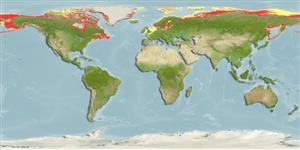>
Perciformes/Cottoidei (Sculpins) >
Cottidae (Sculpins)
Etymology: Myoxocephalus: Greek, myos = muscle, and also, mouse + Greek, kephale = head (Ref. 45335); quadricornis: From Lönnberg..
More on author: Linnaeus.
Issue
Some authors use the genus Triglopsis for this species. See the list of references in Eschmeyer (CofF ver. Sep. 2011: Ref. 88002). More studies are needed.
Environment: milieu / climate zone / depth range / distribution range
Sinh thái học
Biển; Nước ngọt; Thuộc về nước lợ gần đáy; Mức độ sâu 0 - 100 m (Ref. 58496). Polar; 83°N - 41°N, 180°W - 180°E
Atlantic and Arctic: Baltic coast of Sweden, Finland, Russia and southwestern to eastern Poland; western coast of Sweden to northern coast of Norway, eastward to White and Barents Sea basins. In Siberia eastward to about Anadyr estuary. Landlocked populations in Sweden, central Finland and Karelia (Ref. 59043). Arctic drainages of North America (Ref. 5723).
Length at first maturity / Bộ gần gũi / Khối lượng (Trọng lượng) / Age
Maturity: Lm ? range ? - ? cm
Max length : 60.0 cm TL con đực/không giới tính; (Ref. 2058); common length : 30.0 cm TL con đực/không giới tính; (Ref. 2058); Khối lượng cực đại được công bố: 260.00 g (Ref. 27547); Tuổi cực đại được báo cáo: 14 các năm (Ref. 12193)
Các tia vây lưng cứng (tổng cộng) : 7 - 9; Các vây lưng mềm (tổng cộng) : 13 - 16; Tia cứng vây hậu môn: 0; Tia mềm vây hậu môn: 13 - 17; Động vật có xương sống: 37 - 42. Identified by the four bony protuberances on the top of the head (the protuberances are smaller in females and young and absent in the freshwater form), the chainlike lateral line, the sharp spines on the preoperculum, and the absence of palatine teeth (Ref. 27547). Gill rakers reduced to rounded, spiny protuberances (Ref. 27547). Soft dorsal often much enlarged in adult males; caudal truncate to slightly rounded (Ref. 27547). Young gray above, with three or four dark saddles below dorsal fins and a dark spot on dorsal side of caudal peduncle; adults are darker; spiny dorsal fin dusted with black; soft dorsal, anal, pectoral and caudal fins have dark bars; pelvic fins pale (Ref. 27547).
Occurs in cold brackish and moderately saline water near the coast (Ref. 27547). Enters coastal rivers and may occur as far as 120 miles inland (Ref. 5723). Landlocked in lakes (Ref. 59043). Maximum depth reported at 100m (Ref. 35388). Benthic (Ref. 58426). Movements are limited to short onshore-offshore seasonal movements and mass movements of fry into shallow water in autumn (Ref. 28908, 28910). Moreover, there are no migrations of large numbers; movement into freshwater and long distances up rivers are apparently undertaken by relatively few individuals at a time (Ref. 27547). Diurnal from November to April but is largely nocturnal the rest of the year (Ref. 28905). Feeds on small crustaceans, fishes (Ref. 4968) and molluscs (Ref. 58426). Spawning takes place in shallow waters, male digs a groove in the gravel where pairing and egg laying occur. Move to deeper water in the spring, where they stay in summer (Ref. 35388). Landlocked populations are locally threatened (Ref. 59043).
Males become territorial and aggressive toward other males with the approach of the spawning season. Two or three days prior to spawning, the females become restless and swim about between short periods of rest. When a female swims over a male, he undulates his body from side to side and raises his spiny dorsal fin, If the female comes to rest near the male, he moves close to her in a series of short darts. Both then fan rhythymically with their pectoral fins, making a hole. The pair lie side by side, with the male's caudal fin twisted under that of the female. The male make rhythmic motions toward the female with his tail, and the motions apparently stimulate her to release her eggs (Ref. 28900, 28901). After spawning the female leaves the nest; the eggs are fanned and guarded by the male until hatching which occurs in the spring (Ref. 27547).
Robins, C.R., R.M. Bailey, C.E. Bond, J.R. Brooker, E.A. Lachner, R.N. Lea and W.B. Scott, 1991. Common and scientific names of fishes from the United States and Canada. Am. Fish. Soc. Spec. Publ. (20):183 p. (Ref. 3814)
IUCN Red List Status (Ref. 130435)
Threat to humans
Harmless
Human uses
Các nghề cá: Các nghề cá là sinh kế
Các công cụ
Special reports
Download XML
Các nguồn internet
Estimates based on models
Preferred temperature (Ref.
123201): -1.8 - 4.3, mean -1 °C (based on 6042 cells).
Phylogenetic diversity index (Ref.
82804): PD
50 = 0.5000 [Uniqueness, from 0.5 = low to 2.0 = high].
Bayesian length-weight: a=0.00724 (0.00579 - 0.00906), b=3.14 (3.08 - 3.20), in cm total length, based on LWR estimates for this species (Ref.
93245).
Mức dinh dưỡng (Ref.
69278): 3.9 ±0.62 se; based on food items.
Thích nghi nhanh (Ref.
120179): thấp, thời gian nhân đôi của chủng quần tối thiểu là 4.5 - 14 năm (tm=3-5; tmax=14; Fec=792).
Fishing Vulnerability (Ref.
59153): Moderate vulnerability (44 of 100).
Nutrients (Ref.
124155): Calcium = 73.6 [14.2, 243.1] mg/100g; Iron = 0.358 [0.135, 1.153] mg/100g; Protein = 18.6 [15.8, 20.9] %; Omega3 = 0.493 [0.205, 1.367] g/100g; Selenium = 13.3 [5.5, 31.9] μg/100g; VitaminA = 9.77 [2.06, 48.14] μg/100g; Zinc = 0.784 [0.313, 1.423] mg/100g (wet weight);
